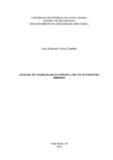| dc.contributor.advisor | Rabenschlag, Denis Rasquin | |
| dc.creator | Thiellet, Luís Eduardo Vieira | |
| dc.date.accessioned | 2020-01-06T13:59:50Z | |
| dc.date.available | 2020-01-06T13:59:50Z | |
| dc.date.issued | 2019-11-27 | |
| dc.date.submitted | 2019-11-27 | |
| dc.identifier.uri | http://repositorio.ufsm.br/handle/1/19283 | |
| dc.description.abstract | The proximity of a fossil fuel shortage and other issues linked to the use of that end up by making the substitution of the oil byproducts necessary. A solution that emerges to solve those issues is the electric automobiles. The present paper presents an economic viability assessment of a hybrid automobile in the city of Santa Maria-RS. Some situations were simulated, the first, that of an ordinary driver, and the second, that of a generic taxi driver from Santa Maria and at the end, other spreadsheets were simulated with the average of the km/year run by a driver with figures reaching between 30,000 and 60,000 ranging every ten to ten thousand in order to foresee under which aspects the investment in the hybrid automobile start to be viable. In the first case, the hybrid cars show to be very unviable. In the second case, with an average of km/year run by a taxi driver in Santa Maria assessed around 50,000, the deducted paybacks resulted in 5 years, the VPL in R$ 4,356.59 and the VAUE in R$ 1,017.33, showing to be viable. With the annual run distances above the 40,000 km/year the paybacks have already started to become interesting, waving as viable scenarios, however the high purchase value of the vehicle must not be ignored, not every person will be able to make this financial input. It is concluded thus that, for the electric vehicles to become a reality, a lot more tax incentive must be implanted by the government and probably the hybrid vehicles will make the transition between the automobiles with ICE and the pure electric. | eng |
| dc.language | por | por |
| dc.publisher | Universidade Federal de Santa Maria | por |
| dc.rights | Acesso Aberto | por |
| dc.subject | Automóvel híbrido | por |
| dc.subject | Análise de viabilidade econômica | por |
| dc.subject | Santa Maria - RS | por |
| dc.subject | Hybrid automobile | eng |
| dc.subject | Economic biability assessment | eng |
| dc.title | Análise de viabilidade econômica de um automóvel híbrido | por |
| dc.title.alternative | Economic viability assessment of a hybrid automobile | eng |
| dc.type | Trabalho de Conclusão de Curso de Graduação | por |
| dc.degree.local | Santa Maria, RS, Brasil | por |
| dc.degree.graduation | Engenharia Mecânica | por |
| dc.description.resumo | A aproximação da escassez dos combustíveis fósseis e outros problemas atrelados ao uso dos mesmos acabam por fazer necessária a substituição dos derivados de petróleo. Uma solução que desponta para resolver esses problemas são os automóveis elétricos. O presente trabalho apresenta uma análise de viabilidade econômica de um automóvel híbrido na cidade de Santa Maria-RS. Foram simuladas algumas situações, a primeira, de um motorista comum, a segunda, de um taxista genérico de Santa Maria e por fim foram simuladas outras planilhas com as médias de km/ano percorridas por um motorista com valores entre 30.000 e 60.000 variando de dez em dez mil afim de prever sob que aspectos o investimento no veículo híbrido começa a ser viável. No primeiro caso os carros híbridos se mostram muito inviáveis. No segundo caso, com a média de km/ano percorrida de um taxista de Santa Maria avaliada por volta de 50.000, o payback descontado resultou em 5 anos, o VPL em R$ 4.356,59 e o VAUE em R$ 1.017,33, se mostrando viável. Com distâncias percorridas anuais acima de 40.000 km/ano os paybacks já começam a se tornarem interessantes, acenando como cenários viáveis, porém não se deve ignorar o alto preço de aquisição do veículo, não são todas as pessoas que podem fazer um grande aporte financeiro. Conclue-se que, para os veículos elétricos virarem uma realidade, muito mais incentivos fiscais devem serem implantados pelo governo e provavelmente os veículos híbridos farão a transição entre os automóveis a MCI e elétricos puros. | por |
| dc.publisher.country | Brasil | por |
| dc.publisher.initials | UFSM | por |
| dc.subject.cnpq | CNPQ::ENGENHARIAS::ENGENHARIA MECANICA | por |
| dc.publisher.unidade | Centro de Tecnologia | por |


